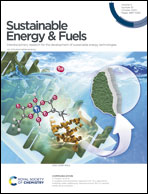Impact of the ammonia decomposition reaction over an anode on direct ammonia-fueled protonic ceramic fuel cells
Abstract
Ammonia has been considered a promising alternative energy carrier due to its high hydrogen content and lack of carbon. Since ammonia readily decomposes into hydrogen and nitrogen at high temperatures, it can be used as a fuel for solid oxide fuel cells (SOFCs). In this work, the effect of the ammonia decomposition reaction over an anode on the performance of direct ammonia-fueled SOFCs was evaluated by electrochemical measurements and catalytic activity tests. A Ni–BaCe0.4Zr0.4Y0.2O3−δ cermet with excellent catalytic activity for ammonia decomposition was employed as the anode material. Impedance analyses revealed that the total cell resistance strongly depended on the ammonia fuel supply conditions. Particularly, the polarization resistance, which was attributed to a mass transfer process in the anode, increased at high ammonia concentrations and flow rates. On the other hand, in the catalytic activity tests, the conversion of ammonia over the cermet decreased under such fuel supply conditions. Hence, it was concluded that the performance of direct ammonia-fueled SOFCs significantly depended on the ammonia conversion over the anode. Additionally, a considerable reduction in the anode temperature as a result of the endothermic ammonia decomposition reaction was confirmed.



 Please wait while we load your content...
Please wait while we load your content...